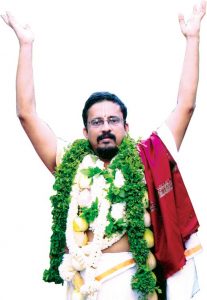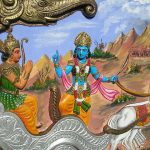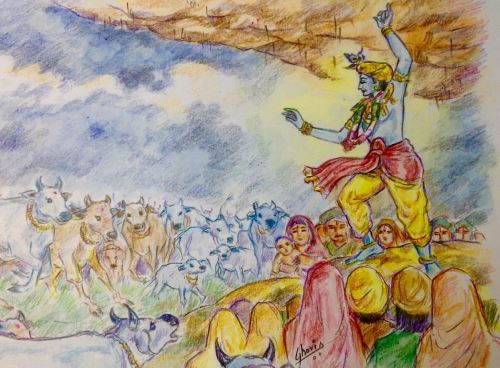
For Bhakti Marga, two granthas are considered very important. Paranur Mahatma Sri Sri Anna Sri Krishna Premi Swamigal, in his work called Bhakti Paatah, explains this. He says,
bhakteh pitA bhAgavatam mAtA gItA yashaswinI
bhakti kAmah paThet tasmAt ashaktah shruNuyAt tathA
(A bhakta’s father is Srimad Bhagavatam, mother is Bhagavad Gita. Those who desire bhakti need to read these, and if they do not have the ability to read, they need to listen to them.)
The one who follows Bhakti Marga is the child, and Bhagavatam is the father (bhakta pitA bhAgavatam) and Bhagavad Gita is the mother (mAta gItA yashaswini). Parents are the guide to lead the child in the correct path, so these two granthas take the role of father and mother to guide the bhakta in the bhakti marga properly. A child knows only the mother first, and it is the mother who shows the child to the father. Similarly a bhakta first comes to know of the Bhagavad Gita. The Gita then shows the magnificent father, Srimad Bhagavatam, to the child. Lord Srinivasa is the Divine Father of the universe, and Goddess Sridevi, the Divine Mother. Just like Sridevi Thayar is present within Srinivasa Perumal, Bhagavad Gita the divine mother, is contained within the majestic ocean of Srimad Bhagavatam, the divine father.
So bhaktas should always read Srimad Bhagavatam and Bhagavad Gita. Even if they do not have the capacity to read, at least they should listen to it. So always do either parayanam or shravanam, to be in the path of bhakti. There is one commonality between these two scriptures.
The greatness of Bhagavad Gita is that it gives several paths to attain the supreme. It is like a rectangular pond or a temple tank, which has steps on all sides. You can take steps down any one side in order to reach the pond. Similarly, there are several margas to attain Bhagavan. One thing that glorifies Bhagavad Gita is that it explains these several margas namely Jnana Yoga, Karma Yoga, Bhakti Yoga, etc. However the biggest glory for Bhagavad Gita is that it came from Bhagavan Himself. It came from the lotus face of Bhagavan Himself, who is the reason for the entire manifestation of the universe, who is the creator and finally takes it all back into Himself. It is that Bhagavan through whom came Bhagavad Gita. This is the greatness of Bhagavad Gita.
Similarly, there is one more shastra that has come out specifically from Bhagavan Himself. All the shastras, Itihasas and Puranas have come from Bhagavan only. But there are two shastras which have come directly from Bhagavan Himself. One of them is Bhagavad Gita, as we saw. The other one is Srimad Bhagavatam. Bhagavatam is in fact sakshat Bhagavad swarupam (Bhagavan Himself in the form of sound or words), and it was also first told by Bhagavan Himself. This path of Bhagavata Dharma that is shown by Srimad Bhagavtam is told by Bhagavan Himself. He allowed other rishis to explain other paths (jnana yoga, karma yoga, raja yoga, etc.) through their sutras, and to propagate those paths in the world. But in the case of Bhagavata Dharma, He is so fond of it that He Himself spells out this path. He speaks of it again and again in Srimad Bhagavatam, in Uddhava Gita and other places. Not only that, the seed for Srimad Bhagavatam itself was given by Bhagavan, through the chatushloki (four slokas) to Brahma Deva in the second Canto. Brahma Deva then gives it to Sage Narada and asks him to expand it. Then Sage Narada gives is to Sage Veda Vyasa, who in turn expounds it in 18,000 shlokas.
So for a bhakta, the Bhagavad Gita is the mother and Srimad Bhagavatam the father who takes him to Bhagavan. Srimad Bhagavatam can also be seen as a commentary for Bhagavad Gita. What the Gita tries to explain as statements, advice or philosophy, Bhagavatam expands on and illustrates in the form of charitrams.
In the Gita, Bhagavan shows the greatness of Bhagavan Nama through this sloka:
api chet sudurAchAro bhajate mAm ananya-bhAk
sAdhur eva sa mantavyah samyag vyavasito hi sah
kshipram bhavati dharmAtmA shaahvach-chhAntim nigachchhati
kaunteya pratijAnIhi na me bhaktah praNashyati
In this sloka, Bhagavan says, “Even an extremely sinful person if he knowingly or unknowingly chants My Divine Name, O Arjuna, his life will not go waste. It is My responsibility to take care of that person and make him a dharmatma. He will be washed of all his sins and purified and finally will even attain My Divine Abode. He will get moksha and come to Vaikunta.” This is purely by Bhagavan’s krupa.
Srimad Bhagavatam illustrates and elaborates on this very aspect through the Ajamila Charitram in its sixth canto. In this charitram we see that Ajamila, who was one who had lost all his good qualities, righteousness, his sadhana and had become a sinful, unlawful and adharmic person, somehow unknowingly chanted Narayana Nama at the time of his death (calling out only to his son called Narayana). However, Bhagavan hears this call and immediately sends his Vishnu Pasharas to save him from the clutches of death and hell, gives him satsang, opens his eyes to the greatness of the Divine Name, purifies him, and finally takes him to His own Divine Abode! Bhagavan’s immense compassion is indeed unfathomable. And this charitram serves to strengthen the devotion and faith of a bhakta that was first kindled by the conviction of Bhagavan’s words in the Gita.
The Bhagavad Gita is indeed the mother whose words are contained within the father of Srimad Bhagavatam!
Sri Shivkumar Murali (Sri Gadadharan), Chennai, India

************************************
Click here to go back to the Aug 2021 newsletter page:
http://godivinity.org/newsletters/nama-dwaar-newsletter-august-2021/
************************************






